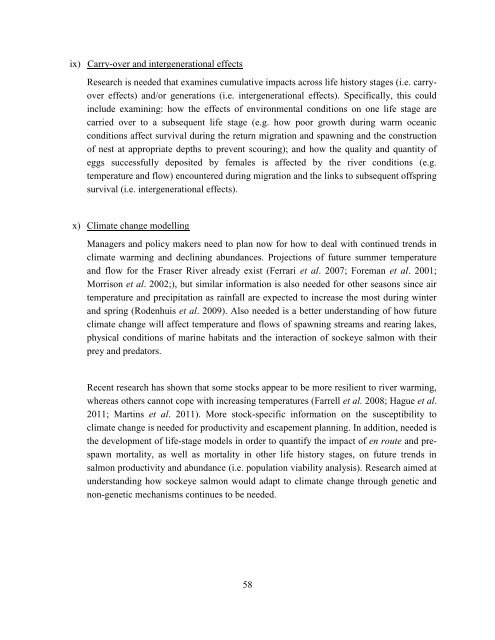Climate Change - Cohen Commission
Climate Change - Cohen Commission
Climate Change - Cohen Commission
Create successful ePaper yourself
Turn your PDF publications into a flip-book with our unique Google optimized e-Paper software.
ix) Carry-over and intergenerational effects<br />
Research is needed that examines cumulative impacts across life history stages (i.e. carryover<br />
effects) and/or generations (i.e. intergenerational effects). Specifically, this could<br />
include examining: how the effects of environmental conditions on one life stage are<br />
carried over to a subsequent life stage (e.g. how poor growth during warm oceanic<br />
conditions affect survival during the return migration and spawning and the construction<br />
of nest at appropriate depths to prevent scouring); and how the quality and quantity of<br />
eggs successfully deposited by females is affected by the river conditions (e.g.<br />
temperature and flow) encountered during migration and the links to subsequent offspring<br />
survival (i.e. intergenerational effects).<br />
x) <strong>Climate</strong> change modelling<br />
Managers and policy makers need to plan now for how to deal with continued trends in<br />
climate warming and declining abundances. Projections of future summer temperature<br />
and flow for the Fraser River already exist (Ferrari et al. 2007; Foreman et al. 2001;<br />
Morrison et al. 2002;), but similar information is also needed for other seasons since air<br />
temperature and precipitation as rainfall are expected to increase the most during winter<br />
and spring (Rodenhuis et al. 2009). Also needed is a better understanding of how future<br />
climate change will affect temperature and flows of spawning streams and rearing lakes,<br />
physical conditions of marine habitats and the interaction of sockeye salmon with their<br />
prey and predators.<br />
Recent research has shown that some stocks appear to be more resilient to river warming,<br />
whereas others cannot cope with increasing temperatures (Farrell et al. 2008; Hague et al.<br />
2011; Martins et al. 2011). More stock-specific information on the susceptibility to<br />
climate change is needed for productivity and escapement planning. In addition, needed is<br />
the development of life-stage models in order to quantify the impact of en route and prespawn<br />
mortality, as well as mortality in other life history stages, on future trends in<br />
salmon productivity and abundance (i.e. population viability analysis). Research aimed at<br />
understanding how sockeye salmon would adapt to climate change through genetic and<br />
non-genetic mechanisms continues to be needed.<br />
58

















